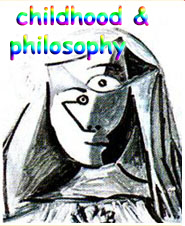immunized infancy: an interpretation of the pied piper of hamelin
DOI:
https://doi.org/10.12957/childphilo.2019.40269Keywords:
infancy, community, immunity, childhood, modernityAbstract
In recent decades, studies of the history of private life have posited infancy as a social and historical construct in which different cultural, economic, and philosophical elements intervene. Based on an interpretation of “The Pied Pieper of Hamelin” (BROWNING, 2003; BROWNING; PISU, 1980; GRIMM; GRIMM, 2000, 1816), this article analyzes the founding characteristics of modern infancy using as Italian philosopher Roberto Esposito’s concept of communitas (2003). Utilizing both the author’s fundamental notion of the latter and several modern and contemporary bibliographic sources about the legend collected by the Grimm brothers, our paper shows how this tale is connected to political changes that led to contemporary forms of pedagogy and shaped what Esposito calls a “modern immunization process” (ESPOSITO, 2005)--a process whereby individuals are disconnected from the commitments and communal duties of pre-modern, pre-nationalist social bonds. This process also affects childhood, which became, by the end of the 19th century altered, isolated, excluded from social bonds with adults, and converted into what we know as “infancy.” Is a different relation with infancy—one that doesn´t exclude children from the community--possible? This paper seeks to open a path toward this possibility.
Downloads
References
ADAMSON, M. T. The Legend of the Pied Piper in the Nineteenth and Twentieth Centuries: Grimm, Browning, and Skurzynski. The Looking Glass: new perspectives on children’s literature, v. 17, n. 1, 2013.
ALZATE PIEDRAHITA, M. V. El “Descubrimiento” de la Infancia (I): Historia de un Sentimiento. Revista Electrónica de Educación y Psicología, n. I, p. 1–11, 2004.
ARIÉS, P. L´enfant et la vie familiale sous l´Ancienne Régime. Paris: Plon, 1960.
ARIÉS, P. El Niño y la Vida Familiar en el Antiguo Régimen. Madrid: Taurus, 1992.
ARISTÓTELES. Aristotle´s Politics. The text o ed. Londres: Spottiswoode and Co, 1877.
ARISTÓTELES. Metafísica. Madrid: Gredos, 1998.
ARISTÓTELES. Política. Madrid: Gredos, 2000.
BAQUERO, R. ¿Existe la infancia? IICE, v. III, 4, 1994.
BROWNING, R. El flautista de Hamelin. Disponível em: <http://www.biblioteca.org.ar/>.
BROWNING, R.; PISU, S. El flautista de Hamelin. El musicue ed. Buenos Aires: Fabbri, 1980.
DERRIDA, J. Dar el tiempo. Madrid: Paidos Ibérica, 1998.
DICKSON, G. The Children´s Crusade. Basingstoke/ New York: Palgrave Macmillan, 2008.
DIRCKX, J. H. The pied Piper of Hamelin. A medical-historical interpretation. Am J Dermatopathol, v. 2, n. 1, p. 39–45, 1980.
DOBBERTIN, H. Quellensammlung zur Hamelner Rattenfängersage. Göttingen: Otto schwartz, 1970.
ELISABETH GRUBER. The City as Commune. In: HOVDEN, E.; LUTTER, C.; POHL, W. (Eds.). Meanings of Community across Medieval Eurasia. Leiden Boston: Brill, 2009.
ESPOSITO, R. Communitas. Origen y Destino de la comunidad. Buenos Aires: Amorrortu, 2003.
ESPOSITO, R. Immunitas. Buenos Aires: Amorrortu, 2005.
ESPOSITO, R. Bios. Biopolítica y Filosofía. Buenos Aires: Amorrortu, 2011.
FEDERICI, S. Calibán y la bruja. Mujeres, cuerpo y acumulación originaria. Madrid: Traficantes de sueños, 2010.
FOUCAULT, M. Vigilar y Castigar. Paris: Anagrama, 1975.
FOUCAULT, M. Nacimiento de la biopolítica. Curso en el Collège de France (1978-1979). Buenos Aires: Fondo de Cultura Económica, 2007.
GOETHE, J. W. Werke. Hamburger Ausgabe. München: C.H.Beck, 1998.
GRIFITH, M. Public and Private in Early Greek Institutions of Education. In: Education in greek and roman antiguity. Leiden Boston Köln: Brill, 2001.
GRIMM, J.; GRIMM, W. Deutsches Wörterbuch. Disponível em:
<http://woerterbuchnetz.de/DWB/?sigle=DWB&mode=Vernetzung&lemid=GK04592#
XGK04592>. Acesso em: 13 maio. 2017.
GRIMM, J.; GRIMM, W. Leyendas alemanas. Barcelona: Magoria, 2000.
GRIMM, W.; GRIMM, J. Deutsche Sagen. Berlin: Nicolai, 1816.
GUTCH, E. The Pied Piper of Hamelin. Folklore, v. 3, n. 2, p. 227–252, 1892.
KANT, I. Über Pädagogik. Königsberg: Friedrich Nicolovius, 1961.
KANT, I. Pedagogía. [s.l.] Libro dot.com, 2005.
LARROSA, J. Pedagogía profana. Estudios sobre lenguaje, subjetividad, formación. Buenos Aires: Novedades Educativas, 2000.
LIEBS, E. Kindheit und Tot. Der Rattenfänger-Mythos als Beitrag zu einer Kulturgeschichte der Kindheit. Munich: Fink, 1987.
LLOYD DE MAUSE. Historia de la Infancia. Madrid: Alianza, 1982.
LOCKE, J. Pensamientos sobre la educación. Madrid: Akal, 2012. v. 53
MASSCHELEIN, J.; SIMMONS, M. La escuela como marca de la democracia. In: El odio a la escuela pública. Buenos Aires: Miño y Dávila, 2009.
MIR, J. M. Diccionario Ilustrado Latín Vox. Barcelona: Spes, 2003.
PABÓN DE URBINA, J. Diccionaro griego-español Vox. Madrid: [s.n.].
PLATÓN. República. Madrid: Gredos, 2000.
RANCIERE, J. El desacuerdo. Política y filosofía. Buenos Aires: Nueva Visión, 2006.
RICHTER, D. Das fremde Kind. Zur entstehung des bürgerlichen Zeitalters. Frankfurt am Main: Fischer, 1987.
ROCHETTI, C. La experiencia de hacer filosofía en la experiencia de enseñar y aprender. [s.l.] Universidad Nacional de Cuyo, 2007.
ROSTEK-LUHMAN, F. Der Rattenfänger von Hameln. Brief der Psychoanalystischen Assoziation, v. 3, p. 42–59, 1992.
SCHULTE, S. Geschichte der Stadt Hammeln. Disponível em:
<https://www.hameln.de/fileadmin/media/Dokumente/Historisches/1264-stadtgeschichte-hameln.pdf>.
SLABY, R.; GROSSMAN, R. Diccionario de las lenguas españolas y alemana. Barcelona: Herder, 1977.
TORRES APABLAZA, I. Soberanía política , inmunidad y excepción. Claves
hermenéuticas sobre la gubernamentalidad neoliberal. Ideas y Valores, v. lxvi, n. 164, p. 79–104, 2017.
VARELA, J.; ALVAREZ URIA, F. La Maquinaria Escolar. Santa Cruz de Tenerife: Ediciones La Piqueta, 1986.
ZOILA SANTIAGO, A. Los niños en la historia. Los enfoques historiográficos de la infancia. Takwá, n. 11–12, p. 31–50, 2007.




